Monday, September 25, 2006
E-Mart
Is the "Happy Happy Song" specifically an E-Mart thing? I've never heard it anywhere else but it plays at E-Mart every single time I'm there. (I don't know the song's actual name, but if you've ever heard it you know exactly what I mean by the "Happy Happy Song".) I know it ought to be annoying, but I've gotten weirdly fond of it, and I'll be disappointed if I ever go to E-Mart and I don't hear it.
There are always a lot of non-Asians shopping at E-Mart. I figure it's partly because Yongsan's probably got the largest foreign population, per capita, on the entire Korean Peninsula. But also E-Mart's got a huge range of products, organized along broadly the same lines as a Western supermarket. Open-air neighborhood markets are scenic and all, but I get the feeling a majority of Western expats prefer something a little more familiar. In any case, I've never felt like the only foreigner around while shopping at E-Mart.
That said, E-Mart's got a business model I've never seen duplicated in the States. At Yongsan, the main sales area is two floors; the top floor sells a range of clothing and other products - rather like K-Mart in the U.S. but with far fewer electronics. The bottom floor is a supermarket. There are escalator-ramps you can take a shopping cart on, and each level has a about a dozen checkout lines where you can pay for goods picked up on either floor. Does this supermarket-retail goods combo exist in the United States?
Subliminal Marketing! In one part of the produce area, they have speakers set up quietly playing the sound of birds singing. Obviously to remind people of the farms this produce supposedly came from - remember this is a metropolitan area of 22 million people and you could probably travel for miles in any direction from E-Mart without ever encountering countryside.
One more thing, a minor anecdote I just want to put out there. I bought some lightweight but bulky storage units at E-Mart, and as they were quite awkward to carry I took a taxi home. The cabdriver initially misunderstood where I wanted to go (probably my fault - I have no illusions about speaking Korean with an accent) but when he realized he'd made a mistake he reset the meter when he changed course. It's nothing, but so many foreigners in this country have stories of bad-tempered, rude cabdrivers that you'd think most cabdrivers here spend their days in a perpetual rage that they sometimes have to give rides to foreigners. Resetting the meter was enough of a gesture to remind me that not everyone fits the negative stereotype.
Friday, September 22, 2006
More Jongno Protests!
This week there was nobody protesting the modern re-interpretation of the history of any ancient kingdoms, but I did see several hundred working-class-looking men and women carrying banners, preceded by a half dozen drummers dressed in colorful old-fashioned costumes, drumming out a beat I could hear even in the 6th floor. Can anyone guess what their grievance was?
They were noraebang (karaoke establishments) workers and brewery employees who demanded the right of noraebang to sell beer on the premises. Traditionally noraebang have a reputation as a place for people to sober up after an evening of drinking, and beer is not permitted.
The Very Long Weekend
My plan is to loaf around Tuesday and then on Wednesday fly to Taiwan to visit an English-teaching friend. I'll try to take plenty of pics of Taipei and whatever other Taiwanese sites we visit. I'll also post a full report on Taiwanese food, which I am looking forward to.
Thursday, September 21, 2006
Cold Stone
This Cold Stone location just opened a few weeks ago, and you could feel the enthusiasm among the employees. They didn't just have fake "service worker" smiles - two employees were stationed outside the front door pulling people in (common enough at nightclubs around here, but at an ice cream shop?) and the employees regularly burst into Cold Stone songs, in both Korean and English. Granted, chain stores in Korea are often overmanned by American standards, but I've never seen, say, Starbucks employees start singing Starbucks-themed songs.
I suspect the Cold Stone in Jongno is the first Cold Stone in the country. Jongno's not the ritziest part of Seoul but it's got good nightlife and it's full of chain stores. Makes sense they'd put the first one here.
Sunday, September 17, 2006
Cafe de Maxwell House
Seoul
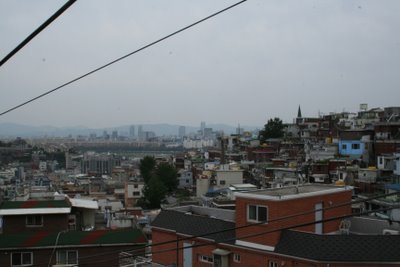
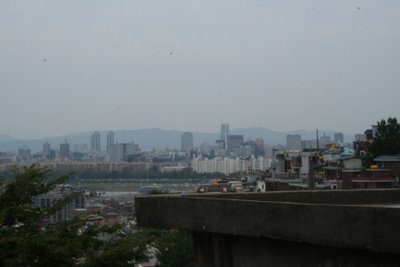 These pics were taken from near the mosque in Itaewon, right where the ground begins to slope away. That's the Kangnam skyline in the background - tallest visible building is the Trade Tower (4th tallest building in the city). Pity there was no blue sky - the view can be breathtaking on a clear day, particularly if it takes you by suprise.
These pics were taken from near the mosque in Itaewon, right where the ground begins to slope away. That's the Kangnam skyline in the background - tallest visible building is the Trade Tower (4th tallest building in the city). Pity there was no blue sky - the view can be breathtaking on a clear day, particularly if it takes you by suprise.
Saturday, September 16, 2006
I have a cold
I've had a cold for the last few days. Nothing serious, but having a runny nose and a hoarse-sounding voice can be annoying. When I lived in Korea from 2002 to 2004, I had serious colds twice - once in November and once in February - and fortunately what I have hasn't approached what I had back then.
Back when I was sick before, it was a lingering cough that was bothering me the most (a lingering cough that had seldom been a problem in the States... can I blame Seoul air pollution here?) I would go to one of the ubiquitous pharmacies in this city, ask for 기침 약 (cough medicine), and I would get some tablets that promised to help for a cough but didn't do anything. Placebos. But my Korean tutor grated some radish and boiled it, creating a revolting drink that looked like saliva but did a better job than commercial medicine.
My chief cold prevention technique is to eat a lot of those wonderful little oranges that are ubiquitous in fall and winter. They're the kind of oranges you can eat with your hands without creating a mess - the peel comes off easily, and the sections are easily separable, like finger food. There are also canned Vitamin C drinks you can get from vending machines.
Thursday, September 14, 2006
Goguryeo Protest
Obviously it was about Goguryeo (or Koguryo, depending on your Romanization preference), an ancient kingdom in northeastern Asia that China claims as part of its cultural heritage and Korea claims as a predecessor of the modern Korean nation. Goguryeo was geographically centered on modern North Korea, but also covered much of modern China. Koreans see Goguryeo as an ancient Korean kingdom (it's one of the famous "3 Kingdoms" of old Korea) while China sees it as a vassal state that got included in the eventual growth of imperial China.
As I understand it, there's more going on here than just national pride and arguing over who gets to write history. There's a real fear that if the North Korean government collapses, China will use its claim on old Goguryeo to favorably redraw the Korean-Chinese border. So it's not just ancient history they're squabbling about.
Still, I can't quite picture hundreds of demonstrators getting together in the US to opine about which country gets to claim an ancient kingdom as their own.
Tuesday, September 12, 2006
An announcement
Saturday, September 09, 2006
Cheonggyecheon pics
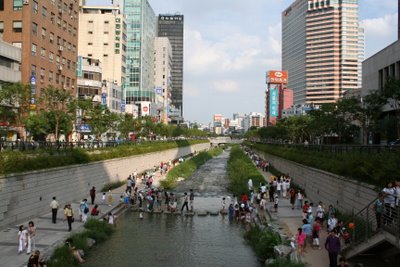 Downtown Cheonggyecheon. On nice days, weekends especially, it's crowded with people enjoying the weather and families on picnics.
Downtown Cheonggyecheon. On nice days, weekends especially, it's crowded with people enjoying the weather and families on picnics. 
A bit further away the people thin out a bit.


Some of the Cheonggyecheon wildlife. I don't know if they were introduced here or if they found the place without human intervention. There are also fish in the stream (not in the downtown section, though) which I suspect were introduced by humans.
Dongdaemun Playground?
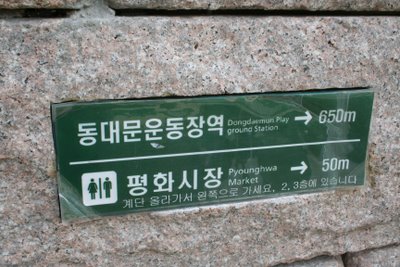 This is one of at least two similar signs near Cheonggyecheon. First, "Playground" might be listed in dictionaries as a possible translation of 운동장, but here it's just not right. It's a stadium. It's called Dongdaemun Stadium.
This is one of at least two similar signs near Cheonggyecheon. First, "Playground" might be listed in dictionaries as a possible translation of 운동장, but here it's just not right. It's a stadium. It's called Dongdaemun Stadium.But it gets worse. This sign directs people not to the playground/stadium, but to the subway station. Dongdaemun Stadium subway station is a major subway station, adjacent to both the stadium and a major shopping area, and as the intersection of 3 subway lines, it's also a major transfer point. I think the fact that every subway map calls it "Dongdaemun Stadium", making it clearly the official name, makes this not the worst mistranslation I've seen, but probably the most inexcusable.
Friday, September 08, 2006
YBM Korean
The class is heavily Japanese and female, along with one Chinese and one Canadian. I was a bit nervous when I thought I might be the only non-Japanese in class, not because I was afraid of being the odd person out, but because Japanese tend to find Korean a much easier language than most other nationalities do. (Though it works both ways, and I've been told many times that if I get really good at Korean, I'll find Japanese a much easier language to learn.)
The class is a bit on the teacher-centered side (I don't think I'll be learning conversation as efficiently as if I'd enrolled at Seogang or Ewha) but it's conducted entirely in Korean, which is good for me. There is homework, but I am going to try to also do all the grammar exercises in the textbook that the teacher never checks.
The class runs for two months, by the end of which we will have finished the rather dull, picture-free YBM textbook. I'll probably go on to level 5 - if my schedule allows it.
Monday, September 04, 2006
They do things differently here
I bet most teenaged or twentysomething Korean men would be thrilled, but I'm underwhelmed. Anyone want some World Cup DVDs?
Sunday, September 03, 2006
Yoko Tagami
I agree that the Korean is not that difficult (far easier than the Level 5 Korean readers Yonsei University puts out). All of the Japanese from the cartoons is preserved intact, with Korean translations on the sides. Now that I've started studying hanja, I'm finding that I can understand bits of the written Japanese, though I still have no idea how to pronounce it. "Japan" (日本) and "Japanese language" (日本語) are written identically in hanja-Korean and Japanese, while the word for Korea (韓國) is only subtly different (Japanese people write 國 slightly differently but it retains its general shape).
Here's a cartoon early in the book:
(Japanese woman gets into a cab)
Woman: (in broken Korean) Take me to Gangnam, please.
Driver: (stern look) Miss - you're not Korean. Are you Japanese?
(Woman looks isolated and frightened, and thinks, 'Yes, I'm Japanese... Textbook controversy... Dokdo...')
Woman: Yes...
Driver: (expression brightening) So what brings you to Korea? How about Korean men? The World Cup...
(Woman thinks, Ah, he just LOOKS scary...)
Another one:
(Yoko is reading a book)
"This book says that Japanese people cannot speak plainly, but Koreans speak very frankly."
Yoko: Ah, really...
(Yoko and a Korean friend are walking down the street)
Friend: Am I gaining weight?
Yoko: Uh...
Friend: Tell me the truth.
(Yoko thinks, "Until now I would have always said, 'No not at all'... but plainly, frankly...)
Yoko: Yes, a little.
(Friend starts crying.)
Friend: REALLY?
(Yoko thinks, "I'm still a long way from understanding foreign culture.")
That said, I have a question about how we in the west treat Japanese names. We always flip Japanese names around so the personal name is first, family name last: Yoko (personal) Tagami(family). Junichiro (personal) Koizumi (family). Even though Japanese names put the personal name last, family name first.
But we maintain the original name order for Chinese and Koreans. Nobody ever talks about Zedong Mao or Jintao Hu. You never hear anything about Jong-il Kim or Moo-hyun Roh. How did it get started?
Maybe we can find the reason through a guy who attended my university a hundred years ago, and is about the sole well-known Korean known in the West with his family name last: Syngman Rhee. His name is also Romanized a bit oddly by Korean standards (if he were living today we'd probably call him Rhee Seung-man) and I always figured it's because he became famous in the West before Korean Romanization got standardized. Maybe Japanese proper names are flipped around because it's a habit Westerners got into a hundred and fifty years ago that never got changed. But Westerners didn't begin to pay much attention to individual Chinese and Koreans until a bit later, and they got into the habit of leaving the order of their names alone.
Ahyeon-dong
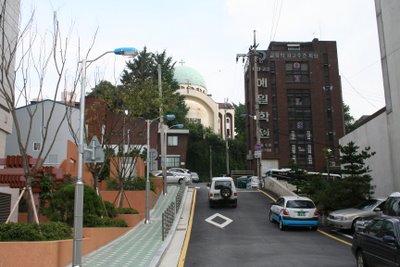 That domed building is a Russian Orthodox Church, the only one I know of in the country. My apartment building is on the extreme right, just barely visible.
That domed building is a Russian Orthodox Church, the only one I know of in the country. My apartment building is on the extreme right, just barely visible. 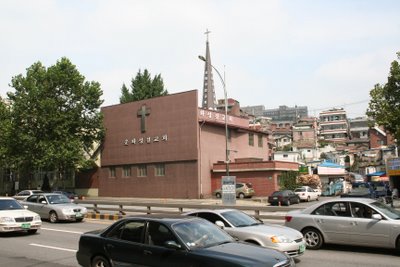
Just to compare, most churches in this city have architecture something like this.

Maporo, the multi-lane road that I live on.
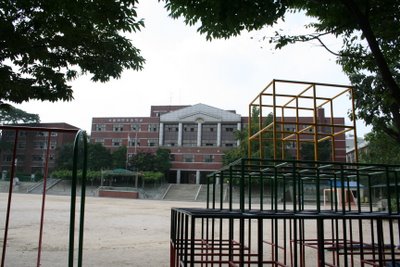 Ahyeon Elementary School, as seen from the road (I poked my camera through a fence).
Ahyeon Elementary School, as seen from the road (I poked my camera through a fence).

Artwork photographed from across the street.
Saturday, September 02, 2006
What I'm reading
It's not really a resource for people learning Korean, as it's mostly in English and the Romanization is quite idiosyncratic, but it's got a lot of interesting information, especially when it comes to the root causes of why Koreans act and think the way they do, or why the culture is shaped the way it is. There are times when the author (whose nationality I'm not sure of) sounds almost like a Korean cultural chauvinist. But when he discusses Neo-Confucianism philosophy and the Chosun Dynasty, he comes close to describing Neo-Confucianism's effects on the Korean people as downright evil. It's Neo-Confucianism that he blames for Korea's relative lack of development prior to the beginning of the Japanese colonial era.
One flaw is that the book is written like it's a reference book, but I cannot imagine anyone actually using it as one. So I've been reading it sequentially, but it's slow going and I can only read a few pages a day.
Friday, September 01, 2006
Durga
Still, Chakraa remains my favorite among Indian restaurants in Seoul, particularly the place near Noksapyeong station up in the direction of Namsan (I forget the neighborhood name). It always seems to be next to empty, and I hardly ever see Korean customers, but it's the cheapest Indian place I know of in the city and they do the southern stuff like dosa and idli.
In Korean food news, I really like hui dopbap. Raw fish, raw vegetables, and rice all mixed together with spicy sauce. It seems so wholesome - like there's nothing in it that could possibly be bad for you. Though I hear that some say you shouldn't eat raw fish in summer.
